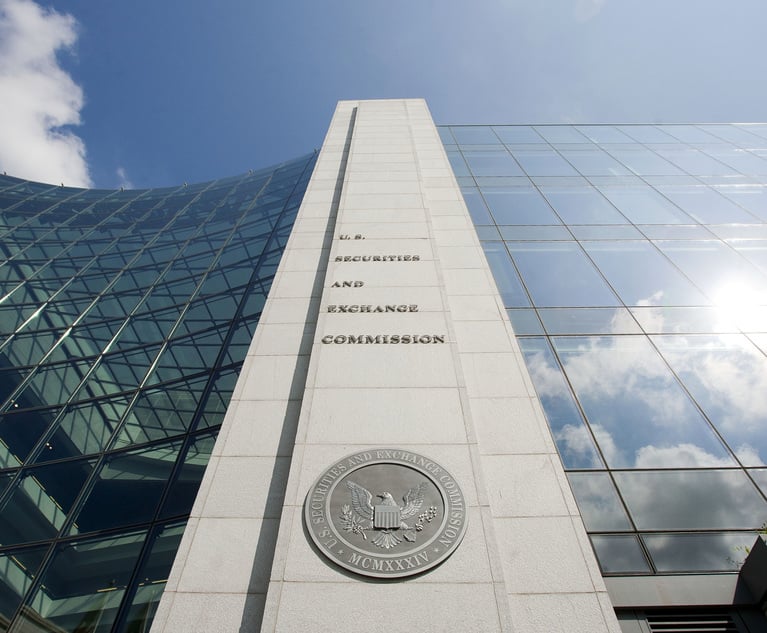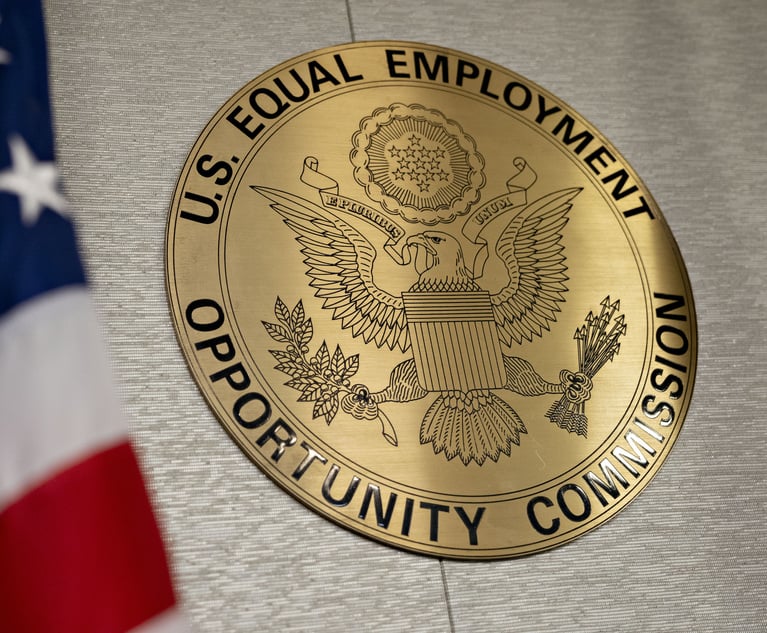Litigation: <em>Cy pres</em> distributions in class-action settlements
The term cy pres comes from the old French phrase cy pres comme possible, meaning as near as possible.
December 27, 2012 at 04:15 AM
5 minute read
The original version of this story was published on Law.com
The term “cy pres” comes from the old French phrase “cy pres comme possible,” meaning “as near as possible.” The legal doctrine of cy pres originated in the charitable trusts context. If a charitable trust's funds could not be distributed according to the precise terms of the trust because the trust's objective had become impossible or illegal to carry out, the cy pres doctrine allowed a court to modify the trust so that the money was distributed in a manner that came “as near as possible” to the testator's original intent.
The cy pres doctrine later emerged in the class-action settlement context. Unlike most commercial litigation matters, the settlement of a class action requires court approval to ensure, among other things, that the settlement is fair, reasonable, and adequately protects the interests of class members. In settlements involving payment of money by the defendant, courts applying the cy pres doctrine will, in certain circumstances, approve agreements providing for distribution of all or part of the settlement amount to charitable or nonprofit organizations instead of to class members. In essence, when it is sufficiently difficult or infeasible to distribute all or part of the settlement amount to class members, the funds are put to their “next best” use in a manner that indirectly benefits the class. For example, some courts allow cy pres distributions of “residual” settlement funds, which occur when a settlement calls for a defendant to pay a certain sum of money into a fund from which individual class members can make claims for payment, but not enough claims are made to exhaust the fund. Some courts also allow cy pres distributions when it is economically infeasible to distribute money to class members, which can happen when, for example, class members cannot be identified or class members' individual damages are too small to justify the administrative expense of delivering payment to each of them. In these instances, some courts will permit the parties to donate the entire settlement proceeds to a charitable or nonprofit organization.
A recent example of a settlement that distributed residual funds pursuant to the cy pres doctrine was in In re Heartland Payment Systems, Inc. Customer Data Security Breach Litigation in the Southern District of Texas. Credit card holders filed the action against a processor of credit card transactions for alleged violations of state consumer-protection laws and other causes of action after hackers breached the defendant's computer systems and obtained the confidential payment information of over 100 million people. As part of the settlement, the defendant created a $1 million fund from which class members could file a claim for payment. Only 11 class members filed valid claims, for a total payout of less than $2,000, with the remainder of the fund paid to nonprofit organizations dedicated to protecting consumers' privacy rights (with an emphasis on payment-systems security). In approving the settlement, the court in Heartland explained that cy pres distribution was an appropriate means of distributing the unclaimed funds: “Cy pres is the only way to avoid having the unclaimed funds…revert to [the defendant], escheat [i.e., transfer] to the government, or provide a huge windfall to the few [class members] who filed valid claims.”
The case of Catala v. Resurgent Capital Services L.P. in the Southern District of California provides an example of a settlement in which the parties agreed that the defendant would provide monetary consideration only through cy pres distributions to third parties, not through payments to class members. The court approved the settlement because the amounts that would otherwise be paid to class members would be dwarfed by the related administrative costs. The court explained that the large number of class members and small amounts of individual damages would result in “de minimus [sic] recovery of approximately 13 cents per class member,” and that the administrative costs of distributing these minimal payouts “would make distribution to class members impracticable.”
Parties considering cy pres provisions for their settlement agreements should be aware of nuances in the law that vary by jurisdiction. California's Code of Civil Procedure, for instance, has a section addressing the types of entities that may receive cy pres distributions of funds unclaimed by class members. The legislature's stated goal is to ensure that such funds “are distributed, to the extent possible, in a manner designed either to further the purposes of the underlying causes of action, or to promote justice for all Californians.” The statute requires distribution “to nonprofit organizations or foundations to support projects that will benefit the class or similarly situated persons, or that promote the law consistent with the objectives and purposes of the underlying cause of action, to child advocacy programs, or to nonprofit organizations providing civil legal services to the indigent.” In contrast, when affirming a lower court's decision to approve the settlement of a nationwide class action, the 1st Circuit stated slightly different criteria for selecting the recipients of cy pres distributions. The 1st Circuit instructed that the manner in which the cy pres recipient will use the funds should “reasonably approximate the interests of the class members.”
As these cases illustrate, parties that are attentive to structuring the settlement in a manner that complies with applicable law in the relevant jurisdiction can, in the right circumstances, employ cy pres distribution as a practical and useful means of effectuating monetary relief in a class-action settlement.
This content has been archived. It is available through our partners, LexisNexis® and Bloomberg Law.
To view this content, please continue to their sites.
Not a Lexis Subscriber?
Subscribe Now
Not a Bloomberg Law Subscriber?
Subscribe Now
NOT FOR REPRINT
© 2025 ALM Global, LLC, All Rights Reserved. Request academic re-use from www.copyright.com. All other uses, submit a request to [email protected]. For more information visit Asset & Logo Licensing.
You Might Like
View All

Trending Stories
Who Got The Work
J. Brugh Lower of Gibbons has entered an appearance for industrial equipment supplier Devco Corporation in a pending trademark infringement lawsuit. The suit, accusing the defendant of selling knock-off Graco products, was filed Dec. 18 in New Jersey District Court by Rivkin Radler on behalf of Graco Inc. and Graco Minnesota. The case, assigned to U.S. District Judge Zahid N. Quraishi, is 3:24-cv-11294, Graco Inc. et al v. Devco Corporation.
Who Got The Work
Rebecca Maller-Stein and Kent A. Yalowitz of Arnold & Porter Kaye Scholer have entered their appearances for Hanaco Venture Capital and its executives, Lior Prosor and David Frankel, in a pending securities lawsuit. The action, filed on Dec. 24 in New York Southern District Court by Zell, Aron & Co. on behalf of Goldeneye Advisors, accuses the defendants of negligently and fraudulently managing the plaintiff's $1 million investment. The case, assigned to U.S. District Judge Vernon S. Broderick, is 1:24-cv-09918, Goldeneye Advisors, LLC v. Hanaco Venture Capital, Ltd. et al.
Who Got The Work
Attorneys from A&O Shearman has stepped in as defense counsel for Toronto-Dominion Bank and other defendants in a pending securities class action. The suit, filed Dec. 11 in New York Southern District Court by Bleichmar Fonti & Auld, accuses the defendants of concealing the bank's 'pervasive' deficiencies in regards to its compliance with the Bank Secrecy Act and the quality of its anti-money laundering controls. The case, assigned to U.S. District Judge Arun Subramanian, is 1:24-cv-09445, Gonzalez v. The Toronto-Dominion Bank et al.
Who Got The Work
Crown Castle International, a Pennsylvania company providing shared communications infrastructure, has turned to Luke D. Wolf of Gordon Rees Scully Mansukhani to fend off a pending breach-of-contract lawsuit. The court action, filed Nov. 25 in Michigan Eastern District Court by Hooper Hathaway PC on behalf of The Town Residences LLC, accuses Crown Castle of failing to transfer approximately $30,000 in utility payments from T-Mobile in breach of a roof-top lease and assignment agreement. The case, assigned to U.S. District Judge Susan K. Declercq, is 2:24-cv-13131, The Town Residences LLC v. T-Mobile US, Inc. et al.
Who Got The Work
Wilfred P. Coronato and Daniel M. Schwartz of McCarter & English have stepped in as defense counsel to Electrolux Home Products Inc. in a pending product liability lawsuit. The court action, filed Nov. 26 in New York Eastern District Court by Poulos Lopiccolo PC and Nagel Rice LLP on behalf of David Stern, alleges that the defendant's refrigerators’ drawers and shelving repeatedly break and fall apart within months after purchase. The case, assigned to U.S. District Judge Joan M. Azrack, is 2:24-cv-08204, Stern v. Electrolux Home Products, Inc.
Featured Firms
Law Offices of Gary Martin Hays & Associates, P.C.
(470) 294-1674
Law Offices of Mark E. Salomone
(857) 444-6468
Smith & Hassler
(713) 739-1250







